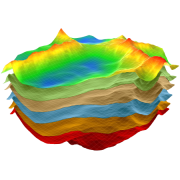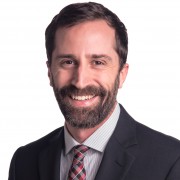Regulatory Compliance Support
DBS&A experts supported U.S. EPA in developing its regulations for permitting carbon dioxide injection (Class VI) wells, as well as EPA’s Class VI technical guidance documents. Since then, we have assisted clients with permitting Class VI wells in more than six states, across multiple EPA regions, as well as in states that have primacy over Class VI permitting.
Complete the form below to request a summary of CARB LCFS requirements for “Sequestration Site Certification” compared to analogous requirements under the U.S. EPA Underground Injection Control (UIC) Class VI program.
Subsurface Analysis and Modeling
Using a wide variety of subsurface data including drilling logs, borehole geophysics, two- and three-dimensional seismic, historical injection and production data, historical pressure and fluid measurements, regional geologic studies, and knowledge of depositional environments, modeling specialists can analyze site conditions and perform simple or detailed reservoir characterizations to support feasibility studies and permit applications. DBS&A modelers are adept at geologic, geochemical, reservoir, and leakage modeling assessments.
Monitoring and Reporting
DBS&A develops and implements field monitoring programs for CCS projects, giving operators, stakeholders, and regulators assurance that injection operations are performed safely and retain protection of groundwater and the environment. Monitoring programs are designed to fit the needs of the project and are optimized to use the most appropriate technologies that meet federal and state regulatory requirements. Our expert data managers ensure this monitoring data is secure, organized, and accessible, with automated workflows to support project reporting requirements.
Information Request
Complete the form below to receive a comparison of California Air Resources Board (CARB) Low Carbon Fuel Standard (LCFS) requirements to the analogous requirements under U.S. EPA Underground Injection Control (UIC) Class VI program.
Select Publications and Presentations
Schnaar, G. 2024. EPA Permitting Process for Class VI UIC Wells (CCUS) and Current Industry Status (Invited Talk). Carbon Capture, Utilization and Storage (CCUS) Conference, Houston, TX. March 11, 2024.
Schnaar, G., C. Wolf, D. Schwartz, S. Finsterle. 2023. Permit Application Development for Planned Saline Formation Injection Project in San Joaquin Valley, California. Carbon Capture, Utilization and Storage (CCUS) Conference, University of Houston, Houston, TX. April 26, 2023.
Schnaar, G., et al., Correction TO: Birkholzer, J.T. et al., 2011. Brine flow up a well caused by pressure perturbation from geologic carbon sequestration: Static and dynamic evaluations. International Journal of Greenhouse Gas Control; Vol. 5: 850–861. Int. J. Greenhouse Gas Control (2013), http://dx.doi.org/10.1016/j.ijggc.2013.05.021
G. Schnaar. Federal UIC Regulations for Geologic Sequestration: An Integrated Approach of Site Characterization, Modeling, and Monitoring. American Association of Petroleum Geologists (AAPG) Rocky Mountain Section Annual Convention, June 2010. Durango, Colorado.
Schnaar, G. 2010. Geologic sequestration of carbon dioxide: simulation for regulators. International Energy Agency Greenhouse Gas Research and Development Program, CO2 Geologic Storage Modeling Meeting. February 2010, Salt Lake City, Utah.
Schnaar, G. 2010. Geologic sequestration modeling and federal regulations. Invited speaker at the International Energy Agency (IEA) Greenhouse Gas R&D Program CO2 Geological Storage Modeling Meeting, Salt Lake City, Utah, February 16, 2010.
Schnaar, G. and S. Cullen, 2009. The hydrology of geologic sequestration. Southwest Hydrology, Vol. 8, No. 5, September/October 2009.
G. Schnaar. Geologic Sequestration of Carbon Dioxide: Models, Codes, and Federal Regulations. TOUGH Symposium, September 2009. Berkeley, California.
G. Schnaar. Federal Regulations for Geologic Sequestration of Carbon Dioxide. Air & Waste Management Association, Carbon Sequestration 101 (via webinar), February 2009.
Schnaar, G. and N. Sweetland. 2008. Geologic sequestration of carbon dioxide: potential impacts to groundwater resources, the U.S. regulatory framework, and lessons learned from previous injection activities. Groundwater Resources Association of California Climate Change: Implications for California Groundwater Management. August 2008, Sacramento, California.
G. Schnaar. Standards for Geologic Sequestration of Carbon Dioxide, EPA Proposed Rulemaking, Signed July 15, 2008.
- Big Sky Regional Carbon Sequestration Partnership Annual Meeting, October 2008. Spokane, Washington.
- EPA Region 8 State UIC Workshop, October 2008. Salt Lake City, Utah.
- WESTCARB Regional Carbon Sequestration Partnership Annual Meeting, October 2008 (via webinar). Anchorage, Alaska.
- EPA Region 7 UIC Manager’s Meeting, September 2008 (via webinar). Kansas City, MO.
- Ground Water Protection Council Annual Meeting, September 2008. Session: Underground Injection Control (UIC) and Geosequestration Seminar.
- Electric Power Research Institute Fall Environment Council Meeting, September 2008. Baltimore, Maryland.
- Edison Electric Institute Global Climate Change Subcommittee Meeting, July 2008. Savannah, Georgia.






